Growing up, I remember being captivated by stories of resilience, navigating cultural identities, and the enduring strength of family. Among these narratives, Rudolfo Anaya’s Bless Me, Ultima resonated deeply. It wasn’t just the tale of a young boy’s coming-of-age, but a profound exploration of Chicano identity in a world grappling with cultural assimilation and the power of tradition. Anaya’s novel, through the lens of Antonio Marez, a young boy growing up in the rural Southwest, painted a vibrant picture of Chicano culture, its struggles, and its enduring spirit.

Image: www.lessonplanet.com
Bless Me, Ultima transcends a simple coming-of-age story, becoming a poignant reflection of Chicano identity in the face of societal pressures. Anaya masterfully weaves together themes of cultural heritage, spirituality, and the complexities of belonging, offering a nuanced portrayal of Chicano life in the mid-20th century.
Exploring the Depiction of Chicano Culture in Bless Me, Ultima
The novel is set in the 1940s in the rural Southwest, where the line between tradition and modernity is blurred. Anaya vividly captures the essence of Chicano culture, showcasing its rich heritage, traditions, and struggles. Through Antonio’s experiences, the reader gains a deep understanding of the complexities of living as a Chicano in a society that often tries to erase their cultural identity.
One of the most prominent elements of Chicano culture portrayed in the novel is the strong sense of family and community. For the Marez family, as with many Chicano families, kinship is more than just blood ties; it encompasses extended family, neighbors, and even the community at large. The novel highlights the profound impact of these interconnected relationships, offering a sense of security and belonging essential for navigating life’s challenges.
Anaya’s portrayal of Chicano culture extends beyond family and community to embrace the profound connection with the land. The Southwest, with its deserts, mountains, and rural landscapes, becomes a character in itself, shaping the lives of the characters as they learn to navigate its beauty and hardship. The reverence for nature resonates with the deep-rooted spiritual traditions embedded within Chicano culture, often drawing on elements of Catholicism blended with indigenous beliefs.
Throughout the novel, religion plays a central role in shaping Antonio’s understanding of the world and his connection to his heritage. Although Catholicism is presented as the dominant religion, Anaya subtly introduces the influence of indigenous beliefs and practices, reflecting the complex blending of spiritual traditions within Chicano culture. This fusion of faith is evident in the role of Ultima, a curandera whose knowledge of healing and spirituality extends beyond traditional Catholic teachings.
Another vital aspect of Chicano culture explored in the novel is the enduring struggle for identity and acceptance. Antonio confronts prejudice and discrimination, facing the challenges of navigating a society often blind to the richness of his heritage. Through Antonio’s experiences, Anaya underscores the complexities of navigating cultural expectations, balancing societal pressures with the desire to embrace one’s roots.
Contemporary Relevance: Chicano Culture in Today’s World
Bless Me, Ultima, despite being set in the 1940s, continues to resonate with contemporary audiences. The novel’s exploration of identity, language, and belonging resonates deeply with Latinos and Chicanos across generations. The book highlights the ongoing struggle for representation, cultural preservation, and the importance of embracing one’s heritage.
In recent years, there has been a growing awareness of the need to celebrate and preserve Chicano culture. This is evident in the flourishing of Chicano art, music, and literature, as well as the increasing visibility of Chicano voices in society. More importantly, there is a growing emphasis on teaching Chicano history and culture in schools, ensuring that future generations understand the richness and complexities of this vital heritage.
Tips for Exploring Chicano Culture
If you are interested in learning more about Chicano culture, here are a few tips:
- Read works by Chicano authors, such as Rudolfo Anaya, Sandra Cisneros, and Richard Rodriguez.
- Explore Chicano art and music. Visit galleries and art centers showcasing Chicano artwork. Experience the rhythms and lyrics of Chicano music, from traditional corridos to contemporary hip-hop.
- Attend cultural events and festivals celebrating Chicano heritage. These events allow you to immerse yourself in the vibrant traditions and expressions of Chicano culture.
- Engage with Chicano communities and organizations actively working to preserve and celebrate their heritage.
By taking these steps, you can gain a deeper understanding of the richness and diversity of Chicano culture and its vital contribution to American society.

Image: www.pbslearningmedia.org
FAQs
What is Chicano Culture?
Chicano culture encompasses the traditions, beliefs, and values of people of Mexican descent living in the United States. It is a multifaceted expression of identity rooted in both Mexican heritage and the shared experiences of living in the United States.
How does Anaya portray the role of women in Chicano culture?
Anaya highlights the vital role of women in Chicano culture. Characters like Ultima, Antonio’s grandmother, and his mother embody the strength, wisdom, and spiritual guidance that women provide within families and communities. They serve as symbols of tradition, offering stability and support amidst the changing world.
What are some key themes explored in Bless Me, Ultima?
Bless Me, Ultima explores various themes, including:
- Identity and Belonging
- Cultural Heritage and Preservation
- Spiritual Growth and Coming of Age
- The Role of Tradition vs. Modernity
How Is Chicano Culture Portrayed In Bless Me Ultima
Conclusion
Bless Me, Ultima offers a powerful and insightful portrayal of Chicano culture, illuminating the complexities of identity, heritage, and the enduring spirit of a community. The novel’s timeless themes of tradition, family, and the search for meaning continue to resonate with readers today. By exploring Anaya’s work and engaging with Chicano culture, we gain a deeper understanding of the diverse tapestry of American society.
Are you interested in learning more about Chicano culture and its portrayal in literature? Share your thoughts and experiences in the comments below!





